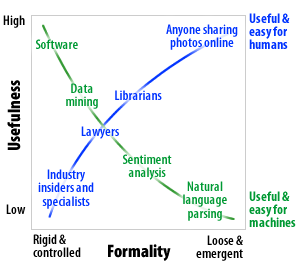
Hashtags are the standard way of adding meaning and context to online content, providing explicit context and making it easier for computers to understand what’s being said. And emoticons are a de facto standard for expressing sentiment that work across cultures and languages. Why haven’t we combined the two?
Hashtags give us context
As we try to understand and organize our online lives, we’re realizing that tagging is essential. Hashtags bridge the gulf between human writers and machine readers. They tell us what the content we’re reading is about, making it easier to categorize and process.
But there’s no standard set of hashtags. This is because information architecture must balance rigidity and flexibility: too formal, and nobody will use it; too variable and it’s hard to categorize and understand. Imagine you had to use only approved hashtags in a message or photo. You’d seldom make the effort to look them up, and few people would adopt them, undermining their usefulness. Just look at these guidelines for hashtags around the Haiti quake, designed to make them machine-readable. They’re a great effort, but hardly easy for casual users to pick up.
On the other hand, many hashtags are meaningless and inconsistent, making them unreliable. Along with the immense creativity that comes from an open system comes tag sprawl. That gives us a tradeoff: easy for people, or easy for machines:

Sentiment matters
Now consider sentiment. If Twitter is a human message bus, alerting us to what the online planet thinks providing us with ambient awareness, then understanding the planet’s sentiment is valuable.
What companies really care about when analyzing things online is a combination of the clout or credibility of the speaker, and the sentiment (see Tara’s breakup with Delta, for example.). A very angry person with no influence might be less of a concern than a mildly disgruntled one with legions of online minions. The formula probably looks something like this:
Because sentiment matters so much, there are dozens of firms trying to infer it from what happens online. They look for keywords — “good”, “sucks”, “idiot” — and perform natural language parsing in an attempt to discern meaning and ferret out false positives. This is hard work, because computers don’t do sarcasm very well. If I say, “oh, great, my house is leaking,” that’s not a very positive sentiment, but it contains the word “great”.
Without a formal taxonomy for sentiment, machines have a hard time inferring true sentiment. But formalizing any system will reduce its adoption by the world at large, which is rather the whole point of this Internet thing in the first place.
Is there a standard for emotions?
There’s at least one de facto standard for emotion online: emoticons. Put aside the really complicated ones, and most people know what 🙂 means. As with Twitter’s Retweet and @name conventions, emoticons were initially devised by users. But today, most online tools understand them — just type one into Skype, or Google Chat, or AIM, and it’ll replace it with artwork.
So it’s surprising that we haven’t combined hashtags (giving meaning and context to a message) with emoticons (a relatively standardized taxonomy of sentiment.)
There are technical impediments to this: some of the characters in emoticons are interpreted as word breaks, and others are blocked to prevent certain security exploits. But there are also lots of reasons to love this approach:
- Hashtag smilies are the best working standard we have for sentiment.
- They’re multilingual and multicultural (assuming we can read them in either direction).
- They’re human-readable.
- They consume just four precious characters of a message.
Ultimately, by combining hashtags and emoticons we could tag sentiment explicitly–making it much easier to process and analyze online communities, collections of links, comment threads, and photo galleries.
And that makes me #:-)






 @
@
 Tags:
Tags: 


 Like all images on the site, the topic icons are based on images used under Creative Commons or in the public domain. Originals can be found from the following links. Thanks to
Like all images on the site, the topic icons are based on images used under Creative Commons or in the public domain. Originals can be found from the following links. Thanks to
Just stumbled on this post. You make a great point, and no doubt an idea like this opens up a clever interface idea for Twitter (& 3rd parties) to generate a revenue stream.
I was just thinking about this mood/sentiment measuring the other day when I saw NBC Chicago's site, which tries somewhat brazenly to make comments on a news site actually useful by putting a huge graphical representation of the comments right next to the news itself (example).
I guess in aggregate the sentiment is all we — and particularly businesses — care about?